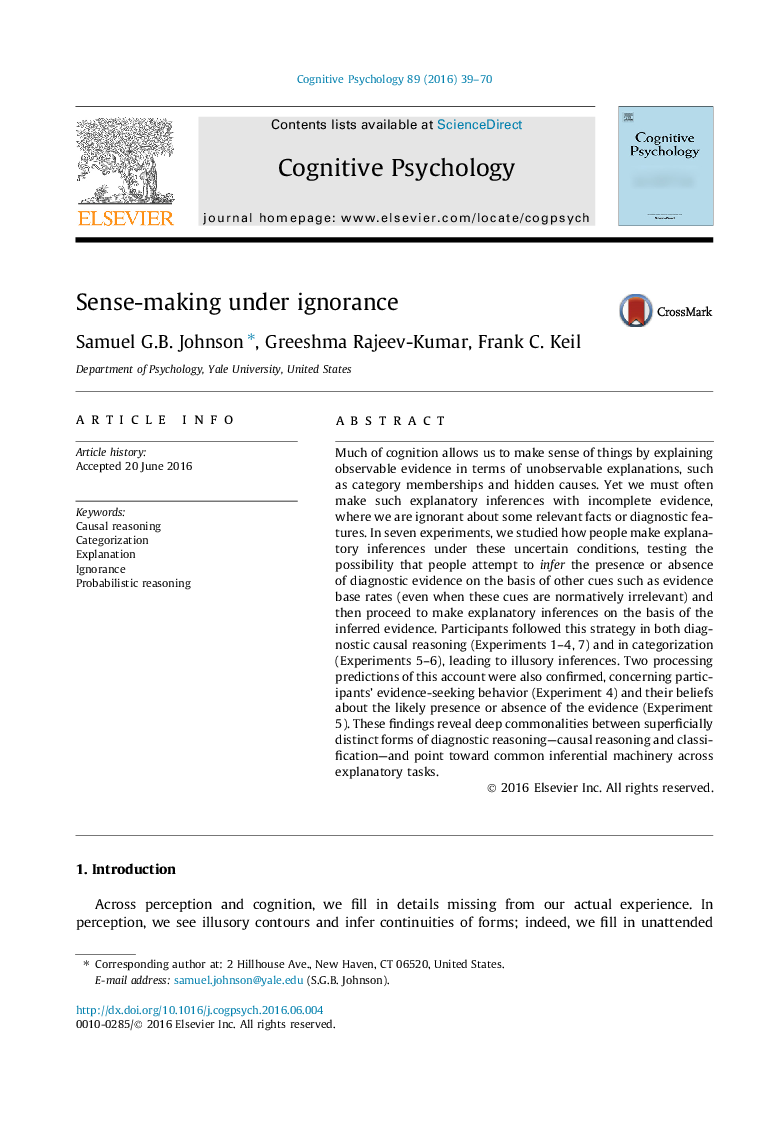| کد مقاله | کد نشریه | سال انتشار | مقاله انگلیسی | نسخه تمام متن |
|---|---|---|---|---|
| 7272705 | 1473375 | 2016 | 32 صفحه PDF | دانلود رایگان |
عنوان انگلیسی مقاله ISI
Sense-making under ignorance
ترجمه فارسی عنوان
حس کردن تحت جهل
دانلود مقاله + سفارش ترجمه
دانلود مقاله ISI انگلیسی
رایگان برای ایرانیان
کلمات کلیدی
استدلال علمی، طبقه بندی، توضیح، نادری استدلال احتمالاتی،
ترجمه چکیده
بسیاری از شناخت به ما امکان می دهد تا از طریق توضیح دادن شواهد قابل مشاهده در رابطه با توضیحات غیر قابل توضیح، مانند عضویت در گروه و علل پنهان، چیزها را درک کنیم. با این حال ما اغلب این نتیجه گیری های توضیحی را با شواهد ناقص می گذاریم، جایی که ما در مورد برخی حقایق مربوطه یا ویژگی های تشخیصی نادان هستیم. در هفت آزمایش، ما بررسی کردیم که چگونه افراد در این شرایط نامطلوب، نتیجه گیری های توضیحی را در نظر می گیرند، آزمایش احتمال اینکه مردم سعی می کنند حضور یا عدم وجود شواهد تشخیصی بر اساس نشانه های دیگر مانند نرخ های مبتنی بر شواهد (حتی زمانی که این نشانه ها از لحاظ قانونی بی اهمیت ) و سپس به نتیجه گیری های توضیحی بر اساس شواهد اثبات شده ادامه دهید. شرکت کنندگان این استراتژی را در هر دو استدلال عقلایی تشخیصی (آزمایشات 1-4، 7) و در طبقه بندی (آزمایشات 5-6) دنبال کردند، که منجر به نتیجه گیری های خیالی شد. دو پیش بینی پردازش از این حساب نیز در مورد رفتار مبتنی بر شواهد شرکت (آزمایش 4) و اعتقادات آنها نسبت به احتمال حضور یا عدم شواهد (آزمایش 5) تایید شده است. این یافته ها نشان می دهد مشترک مشترک عمیق بین اشکال متمایز ظاهری از استدلال و استدلال عقلانی تشخیصی و طبقه بندی - و اشاره به ماشین آلات استنادی مشترک در سراسر وظایف توضیح.
موضوعات مرتبط
علوم زیستی و بیوفناوری
علم عصب شناسی
علوم اعصاب شناختی
چکیده انگلیسی
Much of cognition allows us to make sense of things by explaining observable evidence in terms of unobservable explanations, such as category memberships and hidden causes. Yet we must often make such explanatory inferences with incomplete evidence, where we are ignorant about some relevant facts or diagnostic features. In seven experiments, we studied how people make explanatory inferences under these uncertain conditions, testing the possibility that people attempt to infer the presence or absence of diagnostic evidence on the basis of other cues such as evidence base rates (even when these cues are normatively irrelevant) and then proceed to make explanatory inferences on the basis of the inferred evidence. Participants followed this strategy in both diagnostic causal reasoning (Experiments 1-4, 7) and in categorization (Experiments 5-6), leading to illusory inferences. Two processing predictions of this account were also confirmed, concerning participants' evidence-seeking behavior (Experiment 4) and their beliefs about the likely presence or absence of the evidence (Experiment 5). These findings reveal deep commonalities between superficially distinct forms of diagnostic reasoning-causal reasoning and classification-and point toward common inferential machinery across explanatory tasks.
ناشر
Database: Elsevier - ScienceDirect (ساینس دایرکت)
Journal: Cognitive Psychology - Volume 89, September 2016, Pages 39-70
Journal: Cognitive Psychology - Volume 89, September 2016, Pages 39-70
نویسندگان
Samuel G.B. Johnson, Greeshma Rajeev-Kumar, Frank C. Keil,
